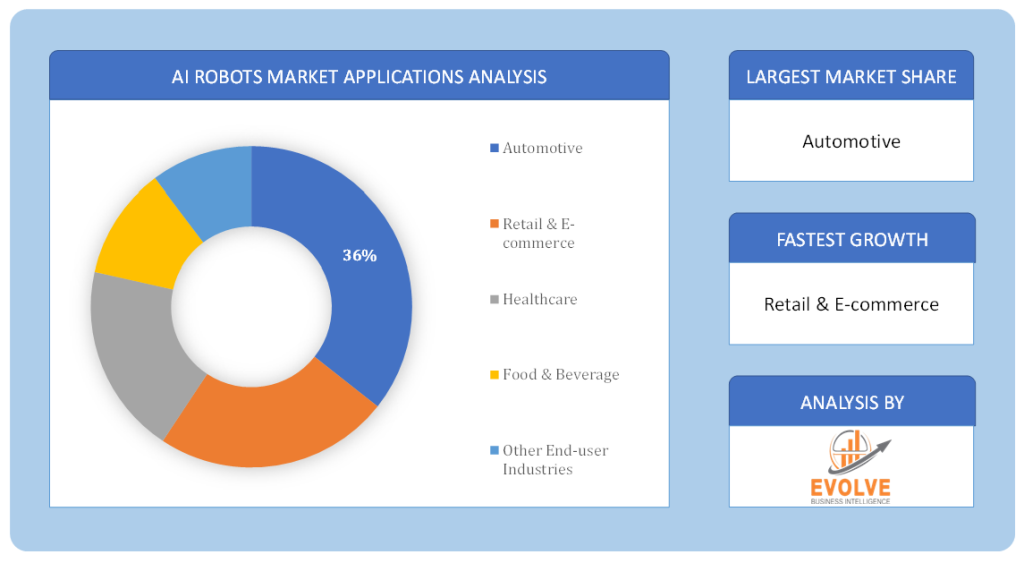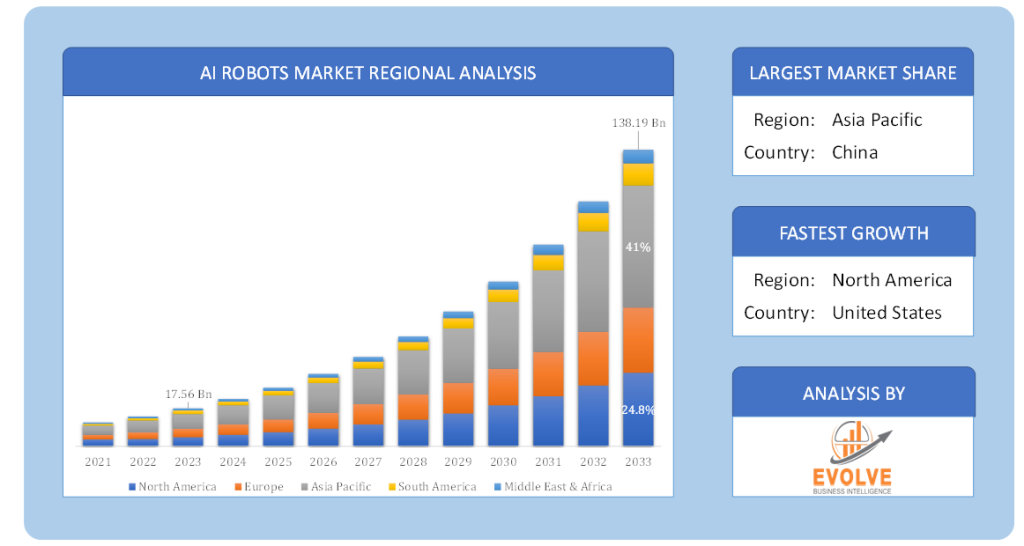AI Robots Market Overview
The global AI Robots Market Size is expected to reach USD 138.19 Billion by 2033. The global AI Robots industry size accounted for USD 17.56 Billion in 2023 and is expected to expand at a compound annual growth rate (CAGR) of 22.91% from 2023 to 2033. Artificial Intelligence (AI) has emerged as a transformative technology, revolutionizing various industries and paving the way for new possibilities. One of the remarkable applications of AI lies in the field of robotics, where AI-powered robots have gained significant traction. The AI robots market has witnessed exponential growth in recent years, offering enhanced efficiency, precision, and adaptability across a wide range of sectors.
AI robots are intelligent machines designed to perform tasks autonomously, using advanced algorithms and machine learning capabilities. These robots possess the ability to perceive their environment, make decisions, and interact with humans and other machines. They have found applications in diverse sectors, including manufacturing, healthcare, retail, logistics, agriculture, and more. AI robots have become indispensable assets, driving operational efficiency and productivity while reducing costs and human errors.
Global AI Robots Market Synopsis
The COVID-19 pandemic had a significant impact on various sectors, and the AI Robots Market was no exception. As the virus spread, industries faced operational disruptions and labor shortages, leading to an increased demand for automation solutions. AI robots emerged as a crucial tool in mitigating the impact of the pandemic, as they could replace human workers in high-risk environments while ensuring continuity of operations. From disinfection robots to AI-powered chatbots for customer support, these robots played a vital role in maintaining business continuity during the crisis.
As we move into the post-COVID era, the AI Robots Market is expected to witness even greater growth. Organizations are increasingly recognizing the need to automate processes to improve resilience, reduce costs, and enhance productivity. The pandemic acted as a catalyst, accelerating the adoption of AI robots across industries. Companies are now investing heavily in robotic technologies to future-proof their operations and gain a competitive edge in the market.
AI Robots Market Dynamics
The major factors that have impacted the growth of AI Robots are as follows:
Drivers:
Ø Advancements in Machine Learning and Artificial Intelligence
One of the key driving factors behind the growth of the AI Robots Market is the rapid advancements in machine learning and artificial intelligence. Machine learning algorithms enable AI robots to analyze vast amounts of data, learn from it, and make intelligent decisions. With continuous learning capabilities, these robots can adapt to changing scenarios, improving their performance over time.
Machine learning algorithms enable AI robots to perform complex tasks with high accuracy and efficiency. For example, in manufacturing, AI robots equipped with machine vision systems can identify defects in products, enhancing quality control processes. In healthcare, AI-powered robots can analyze medical images, assisting doctors in diagnosis and treatment planning. These advancements in machine learning and AI algorithms have significantly expanded the capabilities of AI robots, driving their adoption across industries.
Restraint:
- High Initial Costs and Implementation Challenges
While the AI Robots Market holds immense potential, the high initial costs associated with implementing AI robot systems can be a restraining factor for some organizations. Developing and deploying AI robots require significant investments in research and development, hardware, software, and training. The upfront costs can be prohibitive for smaller businesses or organizations operating on tight budgets.
Moreover, the implementation of AI robot systems can pose technical and operational challenges. Integrating AI robots into existing workflows and ensuring seamless collaboration between humans and robots requires careful planning and expertise. Lack of technical know-how and resistance to change within organizations can further hinder the widespread adoption of AI robots. However, as technology advances and economies of scale come into play, the costs associated with AI robot systems are expected to decrease, making them more accessible to a broader range of industries and organizations.
Opportunity:
Growing Demand for Collaborative Robots
One of the significant opportunities in the AI robots market lies in the growing demand for collaborative robots, also known as robots. Collaborative robots are designed to work alongside humans, augmenting their capabilities and improving productivity. These robots possess advanced safety features, enabling safe human-robot interaction without the need for physical barriers. With the rise of flexible manufacturing processes and the need for efficient human-robot collaboration, cobots are expected to witness substantial demand. The ability to automate repetitive and physically demanding tasks while maintaining a safe working environment presents a significant opportunity for the AI robots market.
AI Robots Segment Overview
By Robot Type
Based on the Robot Type, the market is segmented based on Industrial Robots, and Service Robots. the Industrial Robots segment holds the largest share in the AI Robots market. the industrial robots segment holds the largest share in the market. Industrial robots are widely adopted in sectors such as automotive, manufacturing, and electronics. There are several reasons behind the dominance of industrial robots in the market. Firstly, the automotive industry heavily relies on industrial robots for various applications, including assembly, welding, painting, and quality control. Secondly, the manufacturing sector, which encompasses a wide range of industries, utilizes industrial robots to enhance efficiency, productivity, and quality.
By End-user Industry
 Based on End-user Industry, the market has been divided into Automotive, Retail & E-commerce, Healthcare, Food & Beverage, Other End-user Industries. the automotive sector holds the largest share in the AI robots market. There are several reasons behind the dominance of the automotive industry in terms of AI robot adoption. Firstly, the automotive industry is characterized by high-volume production, complex assembly processes, and stringent quality standards. Secondly, the automotive industry’s demand for customization and flexible manufacturing has increased with changing consumer preferences. AI robots enable automotive manufacturers to achieve greater flexibility by quickly adapting to different product configurations and variations.
Based on End-user Industry, the market has been divided into Automotive, Retail & E-commerce, Healthcare, Food & Beverage, Other End-user Industries. the automotive sector holds the largest share in the AI robots market. There are several reasons behind the dominance of the automotive industry in terms of AI robot adoption. Firstly, the automotive industry is characterized by high-volume production, complex assembly processes, and stringent quality standards. Secondly, the automotive industry’s demand for customization and flexible manufacturing has increased with changing consumer preferences. AI robots enable automotive manufacturers to achieve greater flexibility by quickly adapting to different product configurations and variations.
Global AI Robots Market Regional Analysis
Based on region, the global AI Robots Market has been divided into North America, Europe, Asia-Pacific, South America and Middle East & Africa. Asia Pacific is projected to dominate the use of the market followed by the Europe and North America regions.
 North America Market
North America Market
North America has been at the forefront of AI and robotics advancements, with the United States leading the market in this region. The presence of established technology giants, research institutions, and a favorable regulatory environment has contributed to the region’s dominance in the AI robots market. The United States is witnessing extensive adoption of AI robots across various industries, such as automotive, healthcare, manufacturing, and logistics. The country’s advanced manufacturing capabilities, coupled with the need for automation and productivity enhancement, have fueled the demand for AI robots. Furthermore, the healthcare sector in North America has witnessed significant adoption of AI robots for tasks such as surgery assistance, patient care, and medical diagnosis. The region’s focus on technological innovation and early adoption of emerging technologies has positioned it as a key market for AI robots.
Asia Pacific Market
Asia Pacific is another prominent region in the AI robots market, driven by countries like China, Japan, and South Korea. China has emerged as a leading player in the global robotics industry, with a strong emphasis on industrial automation and manufacturing. The country’s robust manufacturing sector and investments in AI and robotics technologies have propelled its position in the AI robots market. Japan, renowned for its technological advancements, has witnessed widespread adoption of AI robots in various industries, including automotive, electronics, and healthcare. The Japanese government has also introduced initiatives to promote the use of AI robots, further fostering market growth. South Korea has made significant strides in robotics and AI, particularly in the development of service robots for healthcare, retail, and entertainment. The region’s rapid industrialization, technological expertise, and government support have positioned Asia Pacific as a key market for AI robots.
Competitive Landscape
The global AI Robots market is highly competitive, with numerous players offering a wide range of software solutions. The competitive landscape is characterized by the presence of established companies, as well as emerging startups and niche players. To increase their market position and attract a wide consumer base, the businesses are employing various strategies, such as product launches, and strategic alliances.
Prominent Players:
- NVIDIA
- Intel
- IBM
- Microsoft
- Xilinx
- Alphabet
- Softbank
- Hanson Robotics
- Amazon
- Blue Frog Robotics
Key Development:
In 2021: NVIDIA is a leading technology company known for its expertise in AI and graphics processing. The company has made significant contributions to the AI robots market by developing powerful hardware and software solutions. NVIDIA’s GPUs (Graphics Processing Units) are widely used for training and inference in AI models, including those used in AI robots. NVIDIA introduced the NVIDIA Jetson AGX Xavier, an AI-powered robotics platform that offers high-performance computing capabilities for advanced robotics applications.
Scope of the Report
Global AI Robots Market, by Robot Type
- Industrial Robots
- Service Robots
Global AI Robots Market, by End-user Industry
- Automotive
- Retail & E-commerce
- Healthcare
- Food & Beverage
- Other End-user Industries
Global AI Robots Market, by Region
- North America
- US
- Canada
- Mexico
- Europe
- UK
- Germany
- France
- Italy
- Spain
- Benelux
- Nordic
- Rest of Europe
- Asia Pacific
- China
- Japan
- South Korea
- Indonesia
- Austalia
- Malaysia
- India
- Rest of Asia Pacific
- South America
- Brazil
- Argentina
- Rest of SouthAmerica
- Middle East &Africa
- Saudi Arabia
- UAE
- Egypt
- SouthAfrica
- Rest of Middle East & Africa
| Parameters | Indicators |
|---|---|
| Market Size | 2033: $138.19 Billion |
| CAGR | 22.91% CAGR (2023-2033) |
| Base year | 2022 |
| Forecast Period | 2023-2033 |
| Historical Data | 2021 |
| Report Coverage | Revenue Forecast, Competitive Landscape, Growth Factors, and Trends |
| Key Segmentations | Robot Type,End-user Industry |
| Geographies Covered | North America, Europe, Asia-Pacific, Latin America, Middle East, Africa |
| Key Vendors | NVIDIA, Intel, IBM, Microsoft, Xilinx, Alphabet, Softbank, Hanson Robotics, Amazon, and Blue Frog Robotics |
| Key Market Opportunities | Advancements in Machine Learning and Computer Vision |
| Key Market Drivers | Advancements in Machine Learning and Computer Vision |
REPORT CONTENT BRIEF:
- High-level analysis of the current and future AI Robots market trends and opportunities
- Detailed analysis of current market drivers, restraining factors, and opportunities in the future
- AI Robots market historical market size for the year 2021, and forecast from 2023 to 2033
- AI Robots market share analysis at each product level
- Competitor analysis with a detailed insight into its product segment, Retail & E-commerce strength, and strategies adopted.
- Identifies key strategies adopted including product launches and developments, mergers and acquisitions, joint ventures, collaborations, and partnerships as well as funding taken and investment done, among others.
- To identify and understand the various factors involved in the global AI Robots market affected by the pandemic
- To provide a detailed insight into the major companies operating in the market. The profiling will include the Retail & E-commerce health of the company’s past 2-3 years with segmental and regional revenue breakup, product offering, recent developments, SWOT analysis, and key strategies.








